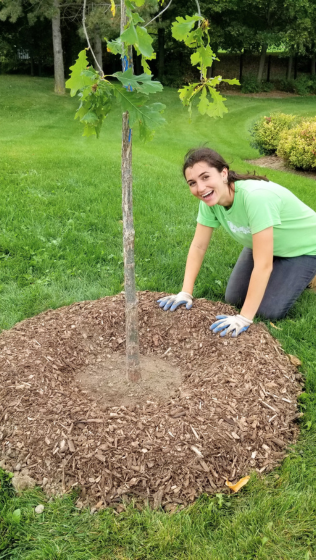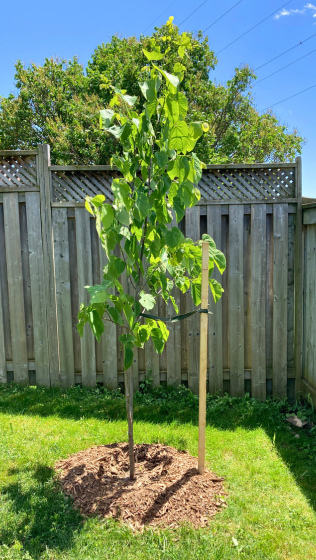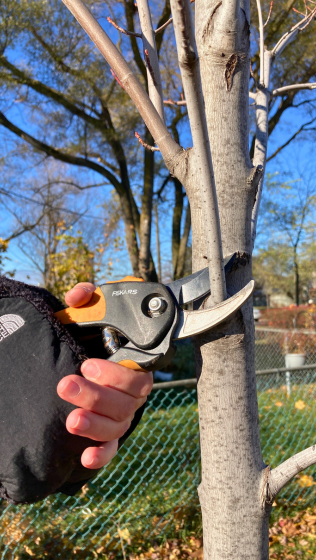Watering

Regular watering is key to healthy trees and shrubs, whether newly planted or well established. Water from early spring (April) to late fall (November), adjusting based on rainfall and soil conditions.
Young Trees (0-3 years after planting): Water twice a week with approximately six gallons of water each time. Six gallons is roughly three full watering cans or a slow trickle from a hose with no nozzle for 15 minutes.
Young Shrubs: Water twice a week with approximately four gallons of water each time. Four gallons is roughly two full watering cans or a slow trickle from a hose with no nozzle for 10 minutes.
Established Trees and Shrubs (3+ years after planting): Water as needed, especially in dry periods. Lay a soaker hose on the soil, circling from the trunk to the edge of the tree’s canopy. Run the water for about one hour to ensure deep watering.
Avoid: watering trees and shrubs with a sprinkler. Wet leaves are more likely to develop fungal diseases.
Avoid: overwatering your tree. If the soil is wet, reduce watering. Remember, heavy clay or compacted soils retain water longer.
Tip: If you are in doubt about whether your tree/shrub needs water, stick your finger into the soil under the mulch. If the soil feels hard and dry, be sure to water, but if it feels damp and cool, you can wait.
Want more watering tips? Read our blog: I Wet My Plants: Watering Tips for Healthy Trees.
Mulching

Mulching your trees and shrubs is a simple and effective way to promote health. Mulch helps to:
- Retain soil moisture
- Regulate soil temperature
- Improve soil quality
- Reduce competition
- Prevent lawn mower damage
- Enhance aesthetics
When mulching, follow these helpful tips:
- Always use natural mulch (undyed woodchips and/or leaves).
- Mulch in a “doughnut” shape, leaving about six inches of space around the trunk/base.
- Spread mulch in a circle around your tree/shrub as far out as you are willing – the bigger the circle, the better!
- Ensure the mulch ring is no more than four inches deep. Two to four inches is ideal.
- Add mulch twice per year – once in the spring and once in the fall.
Avoid: piling mulch in a “volcano” shape around the trunk as mulch retains moisture and can promote rot.
For more information on mulching, check out our blog: Don’t Skip the Chips: Five Mulching Must-Knows.
Soil Health

Healthy soil supports root development, retains moisture, provides essential nutrients and fosters beneficial organisms – all vital for the health of your trees and shrubs.
While not required, adding organic compost can improve soil quality over time. Add a one to two centimetre layer of organic compost (e.g., leaves or sheep/cow manure) under the mulch ring, which will slowly release nutrients and promote thriving plants.
Avoid using high-nitrogen, synthetic fertilizers on your lawn and garden. They can burn roots and cause rapid top growth of your tree/shrub before the trunk/base is large enough to support it.
Avoid using pesticides and herbicides on your lawn and garden. These can damage or even kill young trees and shrubs. They also harm pollinators, birds and other beneficial wildlife, not to mention pets and people.
Tip: Leaves are nature’s compost! Instead of raking and bagging in the fall, leave them to decompose and feed your soil naturally.
Learn more about the power of fallen leaves in our blog: Leave Your Leaves This Fall.
If you live in a newly constructed home, chances are your soil needs help! Learn more about making your soil healthier with our blog: Soil Help for Newly Constructed Homes.
Staking

Most newly planted trees don’t need staking. In fact, allowing a young tree to sway in the wind will help it grow stronger roots and a sturdier trunk, making it more stable over time.
Temporarily staking can be helpful if a tree is at risk of vandalism, is top-heavy or is planted in a very windy location.
How to Stake a Tree (If Needed):
- Place the stakes. Use one or two six-foot tall wooden stakes, placing them at least two feet away from the trunk just outside of the mulch ring. If using two stakes, place them on opposite sides of the tree. If using one stake, place it on the side the wind comes from (usually the west) or opposite of the lean.
- Loosely fasten ties. Use soft, flexible material (old nylons are perfect for this!) to loosely secure the tree and stake(s) at about three to four feet above the ground. Allow for some movement as this promotes healthy root growth and reduces trunk injury.
- Remove the stake(s) and ties after one year. Leaving stakes or ties too long can girdle the trunk and cut into the delicate conductive tissue just under the bark, causing serious damage to your tree.
Tip: Don’t stake unless necessary! Improper or unnecessary staking can lead to stunted root development, weak trunks and long-term damage.
Learn more about staking in our blog: The Truth About Staking Young Trees.
Pruning

Pruning helps support strong structure and overall tree and shrub health - when done correctly!
In the first two years after planting, only remove dead, broken, diseased or damaged branches.
As the tree/shrub grows, pruning may not be needed unless there are structural or health concerns.
Structural pruning is best done three to five years after planting (depending on species and rate of growth) to correct problems such as crossing branches, tight spacing, undesirable branch angles or directions or multiple leaders (the vertical stem(s) at the top of the trunk.
Avoid removing more than a quarter of the leaf area in a single year. This can stress the plant and reduces its ability to produce food.
Avoid using wound paint after pruning. This interferes with the tree/shrub’s natural healing process. Exceptions include cases where the prevention of oak wilt spread is a factor.
Tip: If you think your tree/shrub needs pruning, follow these tips to select a qualified tree care company. More information on pruning can be found here.
Do you have a LEAF-planted tree that is under 14 feet (4 meters) tall? We offer corrective pruning for young trees that LEAF has planted.
For more information on pruning, check out our blog: Tree Pruning 101.
Protection

Urban trees and shrubs face many hidden threats, especially physical damage. Protect your trees and shrubs with these simple tips:
Prevent Physical Damage Year-Round:
- Don’t attach things to your tree. Rope, string or wire can girdle the bark and restrict water and nutrient flow. Nailing objects like bird houses creates entry points for pests and disease.
- Never mow or weed-whack near trunks. This can injure bark and the vital vascular tissue beneath it. A ring of mulch acts as both a buffer and visual reminder.
- Avoid hard surfaces near your tree/shrub. Paving stones, bricks and concrete block air and water from reaching roots.
- Don’t pile or store materials under the canopy of your tree. Stored soil, mulch or construction supplies block air and water from penetrating the soil.
- Prevent soil compaction. Activities like driving, grading or construction can compact soil. Compaction reduces space available for water and air and reduces the microbial life that is essential for healthy soil.
- Protect trees/shrubs during renovations. Create a wide protection zone. Roots often extend out up to three times the height of the tree/shrub. Damage now can lead to decline years later.
Winter Protection Tips:
- Guard against rodents. Install breathable plastic tree guards or wire mesh around the base of your tree/shrub to prevent chewing. Remove guards in early spring to avoid moisture build-up and potential trunk decay.
- Protect evergreens from salt spray. If your evergreen is near a road or sidewalk, create a burlap screen using four stakes. Wrap the four stakes with burlap. Leave space between the burlap and the branches to allow air circulation.
- Avoid salt. Salt harms roots and soil. Instead, try chopping away ice and using sand or other earth-friendly alternatives.
For more great tips on winter care and protection, check out our blog: Don’t LEAF Your Trees Out in the Cold: Winter Tree Care 101. You can also read our Top 10 Things To Do For Your Trees.
Pests and Diseases

The following are links to common pests and diseases that may affect tree and shrub health.

